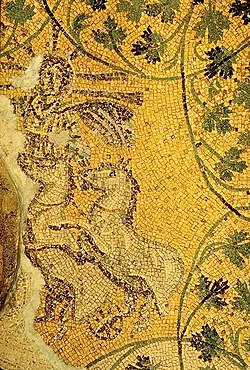| Revision as of 09:17, 18 December 2024 edit2.32.6.171 (talk) This is from the tardo period in which Helios and Apollo were merged. For the last time I actually work at the Vatican as an archeologist. My colleague Valeria and do tours as well so why don’t you actually take a tour and learn instead of changing it just bc you think you are correct.Tags: Mobile edit Mobile web edit← Previous edit | Revision as of 09:18, 18 December 2024 edit undo2.32.6.171 (talk)No edit summaryTags: Mobile edit Mobile web editNext edit → | ||
| Line 13: | Line 13: | ||
| }} | }} | ||
| The popularly named "'''Tomb of the Julii'''" (Mausoleum "M") survives in the ] beneath ]. The serendipitous discovery near the ] has a vaulted ceiling bearing a ] depicting ] with an ] riding in his chariot, within a framing of rinceaux of vine leaves. While scholars agree that this is a depiction of Apollo, |
The popularly named "'''Tomb of the Julii'''" (Mausoleum "M") survives in the ] beneath ]. The serendipitous discovery near the ] has a vaulted ceiling bearing a ] depicting ] with an ] riding in his chariot, within a framing of rinceaux of vine leaves. While scholars agree that this is a depiction of Apollo, this mosaic is from the Tardo period in which Helios and Apollo were often merged. The mosaic is dated to the late 3rd century to early 4th century (Tardo period). Other mosaics in this tomb depicting Jonah and the whale, the good shepherd carrying a lamb (the '']'' motif), and fishermen have encouraged its interpretation as a Christian tomb. | ||
| This tomb was first discovered in 1574 AD when workmen accidentally broke through the ceiling while conducting some floor alterations in the basilica. The inside was briefly explored and documented before the opening was sealed over once more.<ref>The Bones of Saint Peter, John Evangelist Walsh 1982</ref> | This tomb was first discovered in 1574 AD when workmen accidentally broke through the ceiling while conducting some floor alterations in the basilica. The inside was briefly explored and documented before the opening was sealed over once more.<ref>The Bones of Saint Peter, John Evangelist Walsh 1982</ref> | ||
Revision as of 09:18, 18 December 2024
Part of the Vatican Necropolis| Tomb of the Julii | |
|---|---|
 Detail of the mosaic Detail of the mosaic | |
| Click on the map for a fullscreen view | |
| General information | |
| Location | Vatican City |
| Coordinates | 41°54′8″N 12°27′12″E / 41.90222°N 12.45333°E / 41.90222; 12.45333 |
The popularly named "Tomb of the Julii" (Mausoleum "M") survives in the Vatican Necropolis beneath St. Peter's Basilica. The serendipitous discovery near the crypt has a vaulted ceiling bearing a mosaic depicting Apollo with an aureole riding in his chariot, within a framing of rinceaux of vine leaves. While scholars agree that this is a depiction of Apollo, this mosaic is from the Tardo period in which Helios and Apollo were often merged. The mosaic is dated to the late 3rd century to early 4th century (Tardo period). Other mosaics in this tomb depicting Jonah and the whale, the good shepherd carrying a lamb (the kriophoros motif), and fishermen have encouraged its interpretation as a Christian tomb.
This tomb was first discovered in 1574 AD when workmen accidentally broke through the ceiling while conducting some floor alterations in the basilica. The inside was briefly explored and documented before the opening was sealed over once more.
See also
References
- Beckwith, John 1979. Early Christian and Byzantine Art (Yale University Press): 19
- Perler, Othmar 1953, Die Mosaiken der Juliergruft im Vatikan (Universitätsverlag): 34–36
- Walsh, John Evangelist. The Bones of Saint Peter (The Chaucer Press): 15
- Specific
- The Bones of Saint Peter, John Evangelist Walsh 1982
Further reading
- Weitzmann, Kurt, ed., Age of spirituality: late antique and early Christian art, third to seventh century, no. 467, 1979, Metropolitan Museum of Art, New York, ISBN 9780870991790